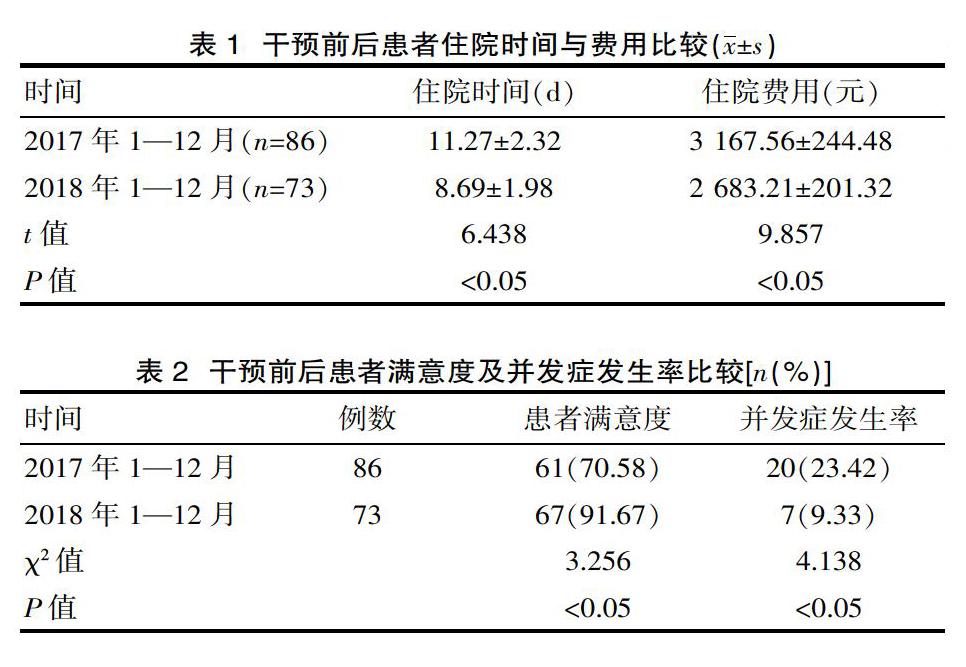品管圈在改善老年肾病综合征患者护理效果中的应用
2020-06-22高泽宇武彦霄
高泽宇 武彦霄



[摘要] 目的 探索品管圈在改善老年肾病综合征患者综合护理措施中的应用效果。方法 成立品质改善小组,对该院2018年1—12月收治的73例肾病综合征患者进行干预,提高其老年肾病综合征患者的护理知识。观察比较对护士采取培训干预前与干預后患者的住院时间、住院费用、满意度、并发症的发生率的差异。结果 干预后老年肾病综合征患者的住院时间和住院费用均显著少于干预前(P<0.05),干预后护理满意度均显著高于干预前(P<0.05),干预后并发症发生率显著低于干预前(P<0.05)。结论 在老年肾病综合征患者护理活动中实施品管圈,有利于促进患者尽快的恢复健康,提高患者临床治疗效果和护理满意度、降低肾病综合征的复发率,提升病区护理质量和改善患者生活质量。
[关键词] 品管圈;老年患者;肾病综合征;护理效果
[中图分类号] R19 [文献标识码] A [文章编号] 1672-5654(2020)02(b)-0065-03
[Abstract] Objective To explore the application of quality control circle in improving comprehensive nursing measures for elderly patients with nephrotic syndrome. Methods A quality improvement team was set up to intervene in 73 patients with nephrotic syndrome admitted to the hospital from January to December 2018, and improve nursing knowledge of elderly patients with nephrotic syndrome. Observe and compare the differences in hospitalization time, hospitalization costs, satisfaction, and incidence of complications before and after training interventions for nurses. Results The length of hospitalization and hospitalization costs of elderly patients with nephrotic syndrome after the intervention were significantly less than before the intervention(P<0.05), and the nursing satisfaction after the intervention was significantly higher than before the intervention(P<0.05), and the incidence of complications after the intervention was significant, lower than before intervention(P<0.05). Conclusion The implementation of quality control circle in the nursing activities of elderly patients with nephrotic syndrome is helpful to promote the patient's recovery as soon as possible, improve the clinical treatment effect and nursing satisfaction of patients, reduce the recurrence rate of nephrotic syndrome, improve the quality of care in ward and improve patients' quality of life.
[Key words] Quality control circle; Elderly; Nephrotic syndrome; Nursing effect
肾病综合征是肾内科的常见病、多发病,以大量蛋白尿、低蛋白血症、高脂血症及水肿为主要特征,具有病情重、病程长、易反复、难治愈的特点[1]。随着医学的发展,众学者对老年肾病综合征进行研究,探讨各种方法来护理老年肾病综合症患者,为了改善该院2018年1—12月收治的73例老年肾病综合征患者的生活质量,该科室建立品质改善小组,采用培训护士的干预措施,规范对患者的指导从而来提高其生活质量,减少并发症的发生,取得了显著效果,现报道如下。
1 对象与方法
1.1 研究对象
选取该院2017年1—12月收治的86例患者(干预前)及2018年1—12月收治的73例肾病综合征患者(干预后)为研究对象。
1.2 研究方法
2017年12月科室成立品质改善小组,对科室30名护士进行培训,提高其老年肾病综合征患者的护理知识。观察比较对护士采取培训干预前与后患者的住院时间、住院费用、满意度、并发症的发生率的差异。
干预措施:通过访谈法获知各位护士对老年肾病综合征患者的培训需求,通过品质改善小组讨论选定培训内容包含以下6个方面:药物指导、饮食护理、控制感染、心理护理、出院指导。培训结束后将以上知识对临床护士进行考核包括理论及实践(健康宣教),了解护士对培训内容的掌握情况。
